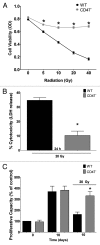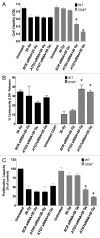CD47 deficiency confers cell and tissue radioprotection by activation of autophagy
- PMID: 22874555
- PMCID: PMC3494592
- DOI: 10.4161/auto.21562
CD47 deficiency confers cell and tissue radioprotection by activation of autophagy
Abstract
Accidental or therapeutic exposure to ionizing radiation has severe physiological consequences and can result in cell death. We previously demonstrated that deficiency or blockade of the ubiquitously expressed receptor CD47 results in remarkable cell and tissue protection against ischemic and radiation stress. Antagonists of CD47 or its ligand THBS1/thrombospondin 1 enhance cell survival and preserve their proliferative capacity. However the signaling pathways that mediate this cell-autonomous radioprotection are unclear. We now report a marked increase in autophagy in irradiated T-cells and endothelial cells lacking CD47. Irradiated T cells lacking CD47 exhibit significant increases in formation of autophagosomes comprising double-membrane vesicles visualized by electron microscopy and numbers of MAP1LC3A/B(+) puncta. Moreover, we observed significant increases in BECN1, ATG5, ATG7 and a reduction in SQSTM1/p62 expression relative to irradiated wild-type T cells. We observed similar increases in autophagy gene expression in mice resulting from blockade of CD47 in combination with total body radiation. Pharmacological or siRNA-mediated inhibition of autophagy selectively sensitized CD47-deficient cells to radiation, indicating that enhanced autophagy is necessary for the prosurvival response to CD47 blockade. Moreover, re-expression of CD47 in CD47-deficient T cells sensitized these cells to death by ionizing radiation and reversed the increase in autophagic flux associated with survival. This study indicates that CD47 deficiency confers cell survival through the activation of autophagic flux and identifies CD47 blockade as a pharmacological route to modulate autophagy for protecting tissue from radiation injury.
Keywords: ATG5; ATG7; BECN1; CD47; MAP1A/1BLC3; autophagosome; ionizing radiation; p62.
Figures









Similar articles
-
CD47 limits autophagy to promote acute kidney injury.FASEB J. 2019 Nov;33(11):12735-12749. doi: 10.1096/fj.201900120RR. Epub 2019 Aug 31. FASEB J. 2019. PMID: 31480863
-
Hypoxia-induced autophagy confers resistance of breast cancer cells to ionizing radiation.Oncol Res. 2012;20(5-6):251-8. doi: 10.3727/096504013x13589503483012. Oncol Res. 2012. PMID: 23581232
-
Divergent roles of BECN1 in LC3 lipidation and autophagosomal function.Autophagy. 2015;11(5):740-7. doi: 10.1080/15548627.2015.1034404. Autophagy. 2015. PMID: 25955014 Free PMC article.
-
Impaired autophagy and APP processing in Alzheimer's disease: The potential role of Beclin 1 interactome.Prog Neurobiol. 2013 Jul-Aug;106-107:33-54. doi: 10.1016/j.pneurobio.2013.06.002. Epub 2013 Jul 1. Prog Neurobiol. 2013. PMID: 23827971 Review.
-
The role of cell signalling in the crosstalk between autophagy and apoptosis.Cell Signal. 2014 Mar;26(3):549-55. doi: 10.1016/j.cellsig.2013.11.028. Epub 2013 Dec 2. Cell Signal. 2014. PMID: 24308968 Free PMC article. Review.
Cited by
-
Atorvastatin Attenuates Radiotherapy-Induced Intestinal Damage through Activation of Autophagy and Antioxidant Effects.Oxid Med Cell Longev. 2022 Aug 31;2022:7957255. doi: 10.1155/2022/7957255. eCollection 2022. Oxid Med Cell Longev. 2022. PMID: 36092168 Free PMC article.
-
Thrombospondins: old players, new games.Curr Opin Lipidol. 2013 Oct;24(5):401-9. doi: 10.1097/MOL.0b013e3283642912. Curr Opin Lipidol. 2013. PMID: 23892609 Free PMC article. Review.
-
Metabolomic Analysis Reveals Unique Biochemical Signatures Associated with Protection from Radiation Induced Lung Injury by Lack of cd47 Receptor Gene Expression.Metabolites. 2019 Oct 8;9(10):218. doi: 10.3390/metabo9100218. Metabolites. 2019. PMID: 31597291 Free PMC article.
-
When cytoprotective autophagy isn't… and even when it is.Autophagy. 2014 Mar;10(3):391-2. doi: 10.4161/auto.27719. Epub 2014 Jan 6. Autophagy. 2014. PMID: 24419177 Free PMC article.
-
Differential regulation by CD47 and thrombospondin-1 of extramedullary erythropoiesis in mouse spleen.Elife. 2024 Jul 9;12:RP92679. doi: 10.7554/eLife.92679. Elife. 2024. PMID: 38979889 Free PMC article.
References
Publication types
MeSH terms
Substances
Grants and funding
LinkOut - more resources
Full Text Sources
Other Literature Sources
Research Materials
Miscellaneous
